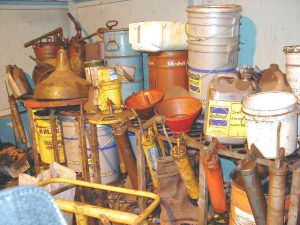Lubrication management is one area where the storeroom and maintenance really do need to work closely together if the required results are to be achieved.
 Many years ago, I was tasked with reviewing a manufacturing facility to help diagnose why they were producing so many ‘seconds’.
Many years ago, I was tasked with reviewing a manufacturing facility to help diagnose why they were producing so many ‘seconds’.
Of course, their aim was to produce ‘first quality’ products but there was also a market for their ‘not quite right’ seconds.
This meant that they could sell the ‘seconds’ at a lower price. Of course they didn’t make as much profit from them but this ‘market’ took the pressure off having to eliminate them altogether. The attitude was, ‘well there is a market for those as well’.
In fact, they budgeted for a certain percentage of production to be seconds.
Unfortunately, before they called me, they had been ‘beating’ that budget – and not in a good way!
The Problem was Lubrication Management Confusion
The company manufactured metal tubing and the key equipment was forming and welding machines but they also used hundreds of metres of conveyors. The conveyors were set up with many ‘gates’ that redirected the tubes to different packaging machines – depending on attributes such as length, ID, and section thickness.
In their own investigations into the excess level of seconds, the company had focussed on the forming and welding equipment and they couldn’t find the source of the problem. My team and I took a broader perspective.
To cut a long story short, we found that the air cylinders that operated the conveyor gates did not function consistently and that this was caused by inappropriate air lubrication management. When the gates were slow in opening, or left partially open, the otherwise Ok tubes, would incur damage that resulted in them being classed as seconds.
Lubrication Management is a ‘Team Sport’
How is this a spare parts management issue? In my book, Spare Parts Inventory Management, I talk about spare parts management being a ‘team sport’, and nowhere is this better demonstrated than with lubrication management.
Lubrication management is one of the most important aspects of maintenance. Get your lubrication management wrong and almost everything else you do is wasted.
An important issue with lubrication is to use the right lubricant for the right situation. Viscosity, strength, adherence, flash point, and pour point are not just words, they are important factors in lubrication (among others that I am sure a tribologist could help with).
And lubrication management is one area where the storeroom and maintenance really do need to work closely together if the required results are to be achieved.
The Storeroom’s Role in Establishing Lubrication Management Protocols
Establishing the right protocols for lubrication management in the storeroom can go a long way to helping ensure that the right lubrication is used in the right place in the plant. This includes proper storage, clear identification, and clean and easy dispensing.
There are many different systems and methods commercially available for lubrication management. Some are as simple as ensuring separation of lubricant types, some involve color coding, and some pre-filtering. What works for you depends on your situation, lubrication needs, and of course budget.
My goal here is not to promote any particular system. What I want to do is raise awareness of the need to ensure that the storeroom and maintenance work together to safe-guard that the right lubricant is identified and then dispensed in a clean and ready-to-use manner.
The Right Foundation is Essential
Of course, getting all of the factors influencing good lubrication outcomes correct involves much more than just the storeroom. But without the storeroom establishing the right foundation, as with lubrication itself, the rest of your efforts may just not matter. In the example above, using the wrong lubricant in the air lubricators for the conveyor gates meant that they made an excess quantity of seconds. Making it easier to tell, at the issuing point, which lubricant to use made all the difference.
At about the time that I helped that company identify that their ‘production problem’ was really a lubrication problem, there was a commercial for motor oil on Australian TV that used the slogan, ‘oils ain’t oils’. Never was a truer word spoken!